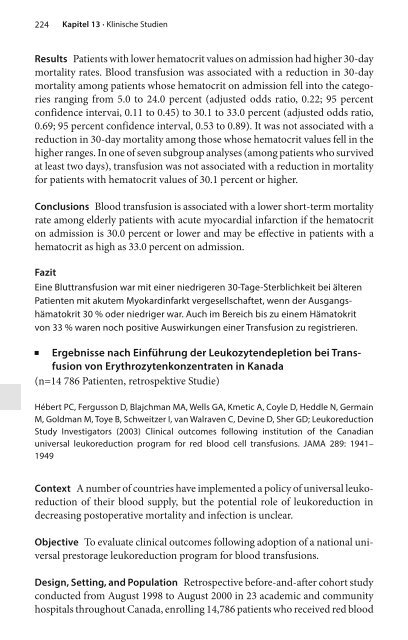Intensivmedizin Fragen und Antworten
Sie wollen auch ein ePaper? Erhöhen Sie die Reichweite Ihrer Titel.
YUMPU macht aus Druck-PDFs automatisch weboptimierte ePaper, die Google liebt.
224 Kapitel 13 · Klinische Studien<br />
Results Patients with lower hematocrit values on admission had higher 30-day<br />
mortality rates. Blood transfusion was associated with a reduction in 30-day<br />
mortality among patients whose hematocrit on admission fell into the categories<br />
ranging from 5.0 to 24.0 percent (adjusted odds ratio, 0.22; 95 percent<br />
confidence intervai, 0.11 to 0.45) to 30.1 to 33.0 percent (adjusted odds ratio,<br />
0.69; 95 percent confidence interval, 0.53 to 0.89). It was not associated with a<br />
reduction in 30-day mortality among those whose hematocrit values fell in the<br />
higher ranges. In one of seven subgroup analyses (among patients who survived<br />
at least two days), transfusion was not associated with a reduction in mortality<br />
for patients with hematocrit values of 30.1 percent or higher.<br />
Conclusions Blood transfusion is associated with a lower short-term mortality<br />
rate among elderly patients with acute myocardial infarction if the hematocrit<br />
on admission is 30.0 percent or lower and may be effective in patients with a<br />
hematocrit as high as 33.0 percent on admission.<br />
Fazit<br />
Eine Bluttransfusion war mit einer niedrigeren 30-Tage-Sterblichkeit bei älteren<br />
Patienten mit akutem Myokardinfarkt vergesellschaftet, wenn der Ausgangshämatokrit<br />
30 % oder niedriger war. Auch im Bereich bis zu einem Hämatokrit<br />
von 33 % waren noch positive Auswirkungen einer Transfusion zu registrieren.<br />
jErgebnisse nach Einführung der Leukozytendepletion bei Transfusion<br />
von Erythrozytenkonzentraten in Kanada<br />
(n=14 786 Patienten, retrospektive Studie)<br />
Hébert PC, Fergusson D, Blajchman MA, Wells GA, Kmetic A, Coyle D, Heddle N, Germain<br />
M, Goldman M, Toye B, Schweitzer I, van Walraven C, Devine D, Sher GD; Leukoreduction<br />
Study Investigators (2003) Clinical outcomes following institution of the Canadian<br />
universal leukoreduction program for red blood cell transfusions. JAMA 289: 1941–<br />
1949<br />
Context A number of countries have implemented a policy of universal leukoreduction<br />
of their blood supply, but the potential role of leukoreduction in<br />
decreasing postoperative mortality and infection is unclear.<br />
Objective To evaluate clinical outcomes following adoption of a national universal<br />
prestorage leukoreduction program for blood transfusions.<br />
Design, Setting, and Population Retrospective before-and-after cohort study<br />
conducted from August 1998 to August 2000 in 23 academic and community<br />
hospitals throughout Canada, enrolling 14,786 patients who received red blood


